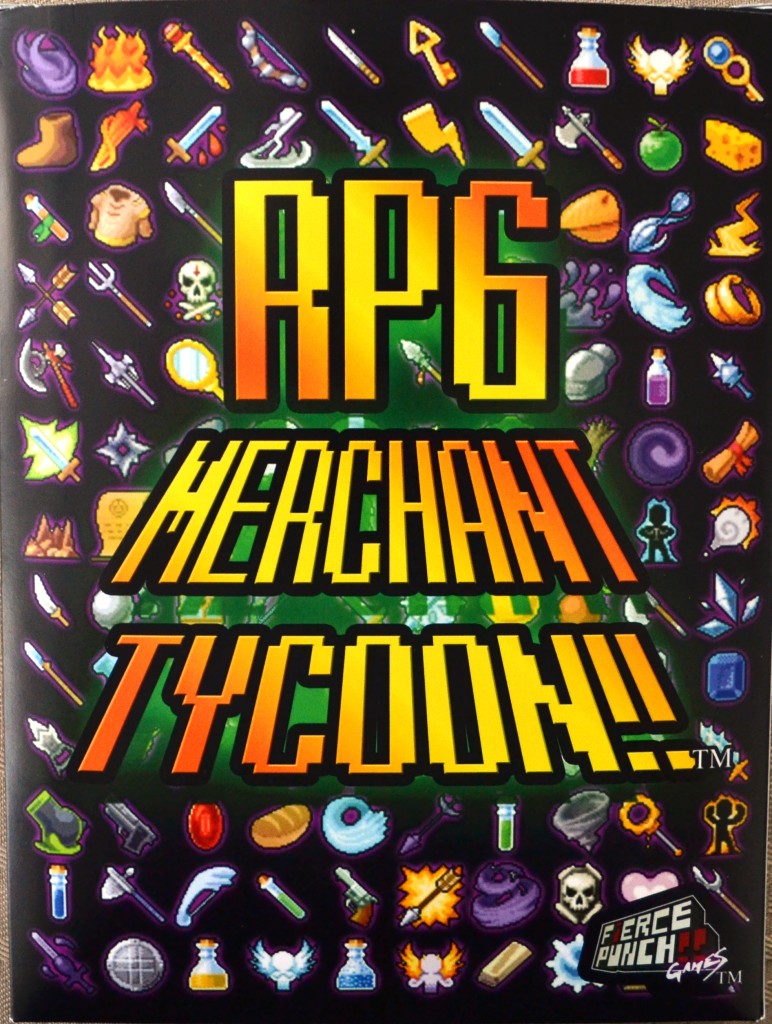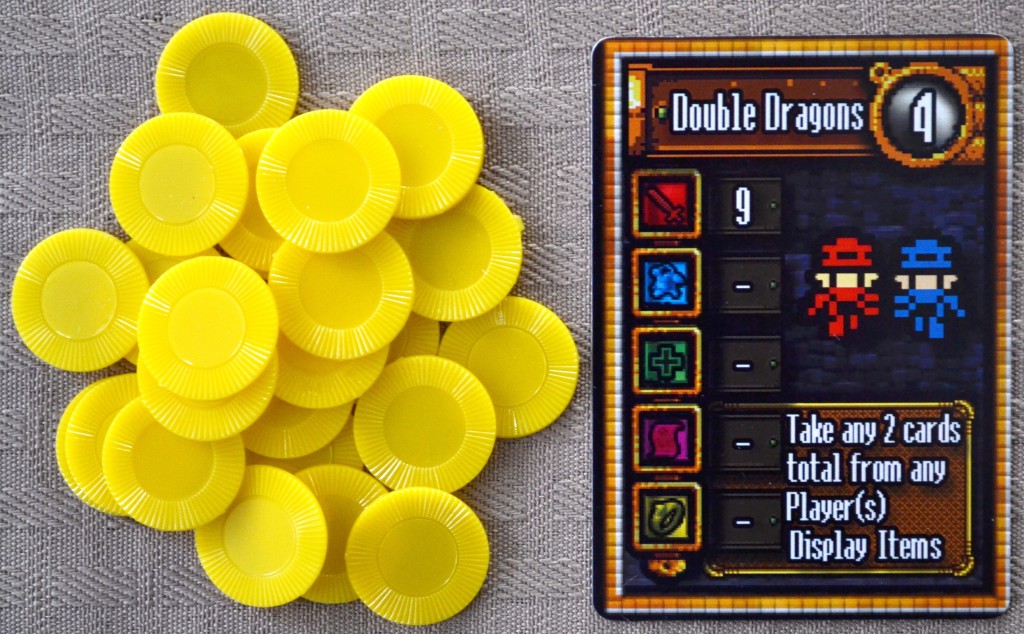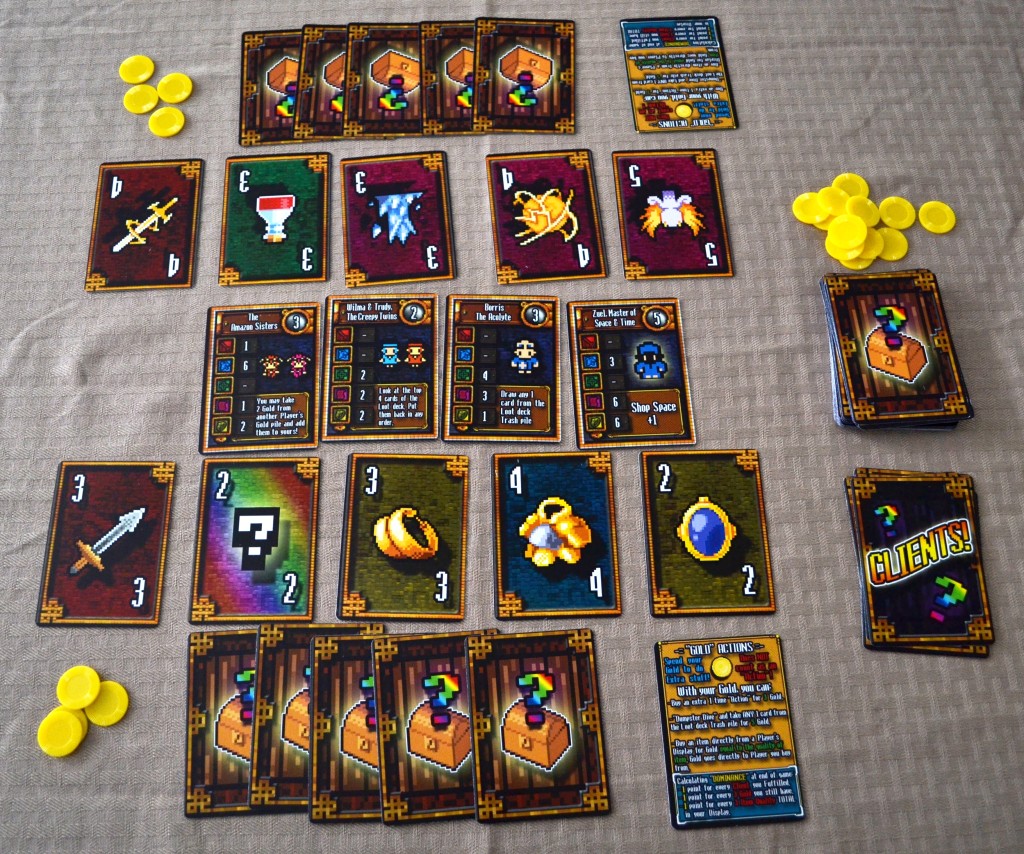Most of us have been there: sword in hand, shield in the other, and a trusty book of spells in your back pocket for emergencies. Whether you’re playing an action game, an RPG, or an adventure game, this scene will probably be second nature to you by now. Enter “RPG Merchant Tycoon!!”, a game that reverses your role and puts you behind a counter. Rather than selling off all the junk you looted from the corpses of your dead enemies to some random NPC, you’ll be running a shop and providing customers with the loot they’ll need to succeed. It’s a bit like “Recettear” minus the dungeon crawling. When I first learned about this game, I initially suspected that it was developed by a disgruntled NPC merchant who was tired of having to buy useless junk…”oh, the irony!” he’d/she’d gleam happily. In all seriousness though, I’d like to thank game designer Ryan Cowler from FiercePunch!! Games for reaching out and providing me with a press copy.
Components
Cards – The game contains seventy-three loot cards, thirty client cards, and four player quick reference cards. Client cards are your customers, each of whom have specific needs. Needs include weapons, armor, healing, spells, and accessories. Clients also come in different gold brackets…the higher the bracket, the more it takes to satisfy them. Loot cards, to sum them up, are played on client cards to satisfy these needs.
Gold Tokens – Players can both earn and spend gold tokens throughout the game. The box includes a total of fifty.
Setup & Gameplay
There’s a little bit of preparation involved in setting up the game, so I’ll give you all an abridged version. First, players will need to prepare the client deck. Players will count out a number of clients for each gold bracket, the number of which depends on how many people are playing the game. In the end, the clients in the “five” bracket go on the bottom of the client deck, with the “fours” being next, and so on until the “ones” are on top. The loot deck is simply shuffled, with ten cards being given to each player to form their starting hand. Players will choose five of their ten cards to place face down in front of them for their “display”. Once everyone has done this, they are flipped face up simultaneously. The cards remaining in a player’s hand is called the “stock”. The player with the highest combined quality on the items shown goes first and four client cards are drawn face up next to each other in the center of the table.
The game is played over a series of player turns (or “workdays”). On a player’s turn, they’ll observe the following phases:
—
Action Phase – The player will be able to perform two of the following actions:
1. Search – The player can draw one card from the loot deck. Each player is limited to having five cards in their stock and five cards in their display.
2. Inventory – The player can combine their stock and display items and redistribute as they wish.
3. Fulfill – The player can use items from their stock (not display) to fulfill a client’s order. The loot cards used to fulfill the order are discarded and the client gets placed near the player for endgame scoring. The client’s listed favor is also resolved (a special event that has an effect on players and/or the game). Another client is drawn from the deck so that four clients remain on the table.
4. Trade – The player may trade their display item(s) with one other player’s display item(s), so as long as the total quality of said items of the current player are equal or greater.
NOTE:
A player can also perform gold actions that do not count toward this “two actions a day” limit:
1. Hired Help – The player can spend three gold to take an extra one-time basic action.
2. Dumpster Dive – The player can spend five gold to take any single card from the loot deck’s discard pile and add it to their stock or display.
3. Snag – The player can buy one or more items from another player’s display for an amount of gold equal to the total amount of the quality of the item(s).
—
Collect Phase – In this phase, a player simply receives gold for any orders fulfilled, equal to the gold bracket value listed on the client card(s).
—
Player turns will continue clockwise until the last client’s order has been fulfilled. Once this happens, players calculate their dominance (or final score) by factoring in the number of clients fulfilled, the amount of gold in their possession, and total loot quality left in their display. The player with the most dominance points is the winner!
The above doesn’t cover all of the rules found in the manual, but should give you an idea as to how the game is played. For more information, you can find the manual here:
https://www.thegamecrafter.com/games/rpg-merchant-tycoon-
The Review
As a retro gamer who enjoys both business sims and virtual RPGs, “RPG Merchant Tycoon!!” is right up my alley. The card art was reminiscent of the old NES/8-bit games I used to play as a kid…”Dragon Warrior” being one of my favorites, even if it was hard and grindy as hell. Needless to say, the nod to old school games wasn’t missed and most certainly appreciated. The quality of the cards themselves were good and I had no complaints in that department. The rules are about thirteen to fourteen pages long, but go pretty in-depth. I recommend that newcomers read through the manual a few times just to get acquainted with what’s going on and how the cards function. Card favors are probably the most complex part of the game (although I didn’t find it to be that hard) and can be either temporary or permanent, which I liked. Our first two player game took about an hour, but our subsequent games took much less time once we knew what we were doing.
The gameplay flowed very well and it was helpful to always have the same goal in mind…that is, satisfy customers with loot cards in order to add them to your score pile. With that said, the plethora of options available on a player’s turn is really what keeps things interesting. There’s definitely a lot of strategy here in the form of choices. Choices like, which client should I be aiming to satisfy with the cards I have available? My hand (stock) limit of five partially addresses multiple clients…which should I hold onto and which should I place into my display? Which of said cards would be appetizing to my opponent to buy up with gold or trade? I have the cards needed to satisfy this client, but his favor (special effect) won’t be as effective if I fulfill his order now…do I risk leaving him out on the table or take him now anyway? It’s constant second-guessing like this that can make some strategy games irresistible to play. Granted, you are at the mercy of the cards you draw, but the differentiating rules between the stock and display help to mix this up a bit.
“RPG Merchant Tycoon!!” is a breath of fresh air, capitalizing on a genre that I often see neglected. The developer most certainly has a video game background and it shows in the way these cards were designed. In case you had your doubts, this is a good thing. Video games often introduce concepts that board games do not (and vice versa), so having a mix of ideas here really makes it unique and fun to play. The game is currently retailing for $23.99 (as of 5/1/14), which I do take issue with. It’s a little pricey for the amount of components in the box, I feel, and what prevented this game from scoring a perfect ten…I think $17.99 or even $19.99 would have been more fair, though this is simply my opinion. “RPG Merchant Tycoon!!” is light enough for the casual gamer, but may be a little intimidating at first. As I mentioned above, there are a lot of choices available to the player. In my experience, casual players dislike thinking too much and prefer a more “on-rails” experience. Then again, it’s hard (and inappropriate) to define and stereotype casual gamers as liking any one thing, so I leave the decision to buy it in your hands. With that said, I really enjoyed playing “RPG Merchant Tycoon!!” and yearn to play it again very soon.
Final Verdict: 9/10
—
You can learn more about and purchase “RPG Merchant Tycoon!!” by visiting the following websites:
https://www.thegamecrafter.com/games/rpg-merchant-tycoon-
—



